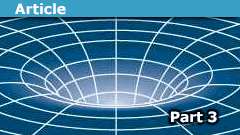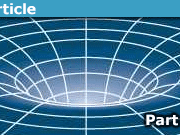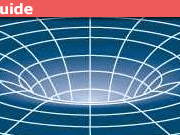The Schwarzschild Metric: A Newtonian Comparison
A Short Proof of Birkoff’s Theorem derived the Schwarzschild metric in units of ##G = c = 1##:
\begin{equation} ds^2 = -\left(1 – \frac{2M}{r}\right)dt^2 + \left(1 – \frac{2M}{r}\right)^{-1}dr^2 + r^2d\theta^2 + r^2 \sin^2\theta d\phi^2 \label{metric} \end{equation}
and I used that metric in The Schwarzschild Metric: Part 1, GPS Satellites to show that Global Positioning System (GPS) clocks in orbit around Earth run faster than Earth-based clocks. We saw that without the appropriate general relativistic correction, GPS tracking would be off by over 11 km per day. I then used that metric in The Schwarzschild Metric: Part 2, The Photon Sphere to discuss the “photon sphere,” i.e., the radial coordinate at which photons orbit ##M##. In this Insight, I will bring the Schwarzschild metric to bear on a simple Newtonian problem, i.e., throwing a ball up into the air from the surface of Earth. While this problem is trivial in Newtonian physics, it’s actually tougher than the problems solved in Parts 1 & 2 of this series using GR. While it’s certainly not advisable to use GR anytime Newtonian physics will suffice, I do so in this case to illustrate the relationship between GR and Newtonian physics.
Here are the two geodesic equations of relevance:
\begin{equation} \frac{d^2r}{d\tau^2} + \Gamma^{1}_{00}\left(\frac{dt}{d\tau}\right)^2 + \Gamma^{1}_{11}\left(\frac{dr}{d\tau}\right)^2 = 0 \label{RgdscEq} \end{equation}
and
\begin{equation} \frac{d^2t}{d\tau^2} + 2\Gamma^{0}_{10}\left(\frac{dt}{d\tau}\right) \left(\frac{dr}{d\tau}\right) = 0 \label{TgdscEq} \end{equation}
where ##\tau## is proper time along the geodesic and, as in Parts 1 & 2 of this series, ##x^0 = t, x^1 = r, x^2 = \theta, x^3 = \phi##. The Christoffel symbols we need are:
\begin{equation} \Gamma^{1}_{00} = \frac{M}{r^2} \left(1 – \frac{2M}{r}\right) \label{Christoffelrtt} \end{equation}
\begin{equation} \Gamma^{1}_{11} = -\frac{M}{r^2} \left(1 – \frac{2M}{r}\right)^{-1} \label{Christoffelrrr} \end{equation}
\begin{equation} \Gamma^{0}_{10} = \frac{M}{r^2} \left(1 – \frac{2M}{r}\right)^{-1} \label{Christoffelttr} \end{equation}
Putting Eq(\ref{Christoffelttr}) into Eq(\ref{TgdscEq}) gives:
\begin{equation} \frac{d}{d\tau}\left(\left(1 – \frac{2M}{r}\right)\frac{dt}{d\tau}\right) = 0 \label{TgdscEq2} \end{equation}
which means:
\begin{equation}\left(1 – \frac{2M}{r}\right)\frac{dt}{d\tau} = B \label{TgdscEq3} \end{equation}
with ##B## a constant. At ##r = \infty## and ##v = 0 ## the metric Eq(\ref{metric}) tells us that ##d\tau = dt ##, since ## ds^2 = -d\tau^2 ## along the geodesic, so Eq(\ref{TgdscEq3}) then tells us ##B = 1 ## when our object is launched with escape velocity ##v = v_e ##. If we get to ##r = \infty## with ## v > 0 ##, then our metric Eq(\ref{metric}) tells us:
\begin{equation} \frac{d\tau}{\sqrt{1-\frac{v^2}{c^2}}} = dt \label{SReqn} \end{equation}
(I restored ##c## here) which tells us ##\frac{dt}{d\tau} > 1 ## so Eq(\ref{TgdscEq3}) says ##B > 1 ## when the object is launched with ##v > v_e ##. Therefore, we assume ##B < 1## when the object is launched with ##v < v_e ##. We’ll need this info on ##B## when we get to our result.
Using this result and putting our other two Christoffel symbols Eq(\ref{Christoffelrtt}) and Eq(\ref{Christoffelrrr}) into our first geodesic equation Eq(\ref{RgdscEq}) gives:
\begin{equation} \left(1 – \frac{2M}{r}\right)\frac{d^2r}{d\tau^2} + \frac{M}{r^2}\left(B^2 – \left(\frac{dr}{d\tau}\right)^2 \right) = 0 \label{RgdscEq2} \end{equation}
Now I will start making approximations to show this leads to the Newtonian conservation of energy equation:
\begin{equation} \frac{1}{2}v^2 – \frac{GM}{r} = \frac{E}{m} \label{Newton} \end{equation}
where ##\frac{E}{m}## is the (conserved) total energy per unit mass of the launched object (I restored ##G##). Start by assuming ##\frac{d^2r}{d\tau^2} = -g = -\frac{GM}{R^2}## where ##R## is the radius of Earth and M is the mass of Earth, i.e., ##g = 9.8 m/s^2## per usual. Next let ##r = R+y## so that ##\frac{dr}{d\tau} = \frac{dy}{d\tau} = v##, i.e., ##y## is the height above Earth’s surface of our projectile; we will assume ##y## is small compared to ##R##. Now Eq(\ref{RgdscEq2}) gives us:
\begin{equation} -\left(1 – \frac{2GMR}{c^2R^2\left(1+y/R\right)}\right)g + \frac{GM}{R^2\left(1+y/R\right)^2}\left(B^2 – \frac{v^2}{c^2} \right) = 0 \label{RgdscEq3} \end{equation}
where I have restored ##G## and ##c##. Expanding:
\begin{equation}\left(1 + \frac{y}{R} \right)^{-1} \approx 1 – \frac{y}{R} \label{approx1} \end{equation}
and
\begin{equation} \left(1 + \frac{y}{R} \right)^{-2} \approx 1 – 2\frac{y}{R} \label{approx2} \end{equation}
and putting these into Eq(\ref{RgdscEq3}) and rearranging we obtain:
\begin{equation}\left(\frac{1}{2} – \frac{y}{R}\right)v^2 + gy = \left(\frac{1}{2} – \frac{y}{R}\right)B^2c^2 – \frac{c^2}{2} + gR \label{RgdscEq4} \end{equation}
Since ##\frac{y}{R} \ll 1 ##, we have ##\left(\frac{1}{2} – \frac{y}{R}\right) \approx \frac{1}{2}##, so Eq(\ref{RgdscEq4}) is now:
\begin{equation}\frac{1}{2}v^2 + gy = \frac{\left(B^2 – 1\right)c^2}{2} + gR \label{RgdscEq5} \end{equation}
The ##gy## on the LHS of Eq(\ref{RgdscEq5}) and ##gR## on the RHS come from ##-\frac{GM}{R\left(1+y/R\right)}## expanded on the LHS of the Newtonian conservation of energy equation Eq(\ref{Newton}) then using ## g = \frac{GM}{R^2}##. That means ## \frac{\left(B^2 – 1\right)c^2}{2}## in Eq(\ref{RgdscEq5}) is our total conserved energy per unit mass ##\frac{E}{m}## from the RHS of Eq(\ref{Newton}). Notice that for ##v = v_e## at launch we have ##B = 1## and the RHS of Eq(\ref{RgdscEq5}) is just ##gR## as expected (total energy equals zero in Eq(\ref{Newton})). If ##v > v_e## at launch, ##B > 1## and the RHS of Eq(\ref{RgdscEq5}) is a little larger than ##gR## (total energy is positive in Eq(\ref{Newton})). If ##v < v_e## at launch, ##B < 1## and the RHS of Eq(\ref{RgdscEq5}) is a little smaller than ##gR## (total energy is negative in Eq(\ref{Newton})).
That concludes my outline of how the geodesic equations for the Schwarzschild metric give rise to standard Newtonian physics for an object launched slowly upwards near the surface of Earth.
PhD in general relativity (1987), researching foundations of physics since 1994. Coauthor of “Beyond the Dynamical Universe” (Oxford UP, 2018).




The link behind is broken (it tries to take one to the edit pane of the intended page).Fixed, thanks!
The link behind and I used that metric in The Schwarzschild Metric: Part 1, GPS Satellites is broken (it tries to take one to the edit pane of the intended page).